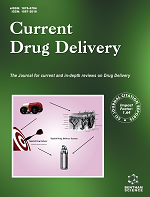- Home
- A-Z Publications
- Current Drug Delivery
- Previous Issues
- Volume 20, Issue 4, 2023
Current Drug Delivery - Volume 20, Issue 4, 2023
Volume 20, Issue 4, 2023
-
-
Highlighting the Potential Role of Exosomes as the Targeted Nanotherapeutic Carrier in Metastatic Breast Cancer
More LessAuthors: Alisha Khera, Hema K. Alajangi, Akhil Khajuria, Ravi P. Barnwal, Santosh Kumar and Gurpal SinghBreast cancer, being the second most common type of cancer, is a leading cause of death in the female population. Of all the available treatments existing for breast cancer, exosomes appear as an important medium for the site targeted delivery of the drugs. Exosomes, unlike all the other extracellular vesicles, play a vital role in the transport of numerous biomolecules throughout the body and can easily be detected becau Read More
-
-
-
Recent Updates on Oral and Dermal Film-based Formulations and their Applications
More LessAuthors: Saily Shinde, Mihir Ghonge and Harsha KathpaliaOn the one hand, oral formulations are susceptible to problems, including instability accompanied by erratic absorption throughout the gastrointestinal tract, first-pass metabolism, and patientrelated and pathological difficulties in consumption. On the other hand, the world has been observing a shift from conventional dermal formulations to the more cosmetically attractive ones. Amid all these, polymeric films and fil Read More
-
-
-
Liposomes in the Targeted Gene Therapy of Cancer: A Critical Review
More LessAuthors: Ashish Akkewar, Nilesh Mahajan, Rohini Kharwade and Purushottam GanganeCancer immunotherapy has advanced significantly in recent years. Nanocarriers like liposomes can improve cancer immunotherapy and even stronger immune responses by improving cell type-specific distribution. Liposomes are lipid bilayer vesicles that are biodegradable and biocompatible and are often used as smart delivery systems for both hydrophobic and hydrophilic bioactive. Whereas the idea of emplo Read More
-
-
-
Fighting Carcinogenesis with Plant Metabolites by Weakening Proliferative Signaling and Disabling Replicative Immortality Networks of Rapidly Dividing and Invading Cancerous Cells
More LessAuthors: Atif K. Wani, Nahid Akhtar, Arun Sharma and Sally A. El-ZahabyBackground: Cancer, an uncontrolled multistage disease causing swift division of cells, is a leading disease with the highest mortality rate. Cellular heterogeneity, evading growth suppressors, resisting cell death, and replicative immortality drive the tumor progression by resisting the therapeutic action of existing anticancer drugs through a series of intrinsic and extrinsic cellular interactions. The innate cellular mechan Read More
-
-
-
Multifunctional 99mTc-5-azacitidine Gold Nanoparticles: Formulation, In Vitro Cytotoxicity, Radiosynthesis, and In Vivo Pharmacokinetic Study
More LessAuthors: Samar S. Ezz Eldin, Hassan M. Rashed, Amira H. Hassan, Heba F. Salem and Tamer M. SakrBackground: 5-azacitidine is a very potent chemotherapeutic agent that suffers from certain disadvantages. Objective: This study aims to prepare gold nanoparticles as a new nano-formula of 5-azacitidine that can improve its bioavailability and decrease its side effects. Methods: 5-azacytidine-loaded GA-AuNPs were prepared and characterized by UV-Vis spectroscopy, infrared (IR), and electronic transmission microscope (TEM) Read More
-
-
-
Synthesis and Characterization of Curcumin Incorporated Multi Component Nano-Scaffold with Enhanced Anti-bacterial and Wound Healing Properties
More LessAuthors: Yi-Ying Wu, Ramya Kumar, Chi-Cheng Wong, Desu Naveen K. Reddy and Fu-Yung HuangBackground: Wound healing is one of the major challenges in chronic diseases; the current treatment options are less effective with undesirable side effects and are expensive. Extensive research is carried out to develop cost-effective, natural, biodegradable wound dressings that can reduce oxidative stress and inflammation and prevent bacterial infections. Curcumin has a plethora of therapeutic applications; however, its low Read More
-
-
-
Formulation and Statistical Evaluation of Tablets Containing Pitavastatin- Self Nano Emulsifying Drug Delivery Systems
More LessAuthors: Sridevi Gowripattapu, D. Sathis Kumar and S. SelvamuthukumarPurpose: To formulate and characterize tablets containing Pitavastatin that have been loaded with a self-nano emulsifying drug delivery system (SNEDDS). Methods: Pitavastatin SNEDDS were prepared with a variety of oils, surfactants, co-surfactants, and solvents to improve the dissolution rate and bioavailability of the HMG-CoA reductase inhibitor. The SNEDDS components were preliminarily investigated for drug solubility i Read More
-
-
-
Preparation of β-CD-Vitexin Microspheres and their Effects on SW480 Cell Proliferation
More LessAuthors: Chengshi Ding, Shumeng Li, Deya Wang, Zhongjing Tian, Meiling Kang, Yingxia Zhang, Jing Ma, Yanmei Deng and Kai ZhangObjective: In order to overcome the insolution and low bioavailability of the vitexin in vivo, β-cyclodextrin-vitexin (β-CD-vitexin) microspheres were prepared, and their effects on the proliferation of SW480 cells were observed. Methods: Scanning electron microscopy, ultraviolet spectrum, Fourier transform infrared spectroscopy, and release rate analysis identified the formation of β-CD-vitexin microspheres. MTT assay det Read More
-
Volumes & issues
-
Volume 22 (2025)
-
Volume 21 (2024)
-
Volume 20 (2023)
-
Volume 19 (2022)
-
Volume 18 (2021)
-
Volume 17 (2020)
-
Volume 16 (2019)
-
Volume 15 (2018)
-
Volume 14 (2017)
-
Volume 13 (2016)
-
Volume 12 (2015)
-
Volume 11 (2014)
-
Volume 10 (2013)
-
Volume 9 (2012)
-
Volume 8 (2011)
-
Volume 7 (2010)
-
Volume 6 (2009)
-
Volume 5 (2008)
-
Volume 4 (2007)
-
Volume 3 (2006)
-
Volume 2 (2005)
-
Volume 1 (2004)
Most Read This Month
Article
content/journals/cdd
Journal
10
5
false
en

Most Cited Most Cited RSS feed
-
-
Preface
Authors: Deng-Guang Yu and He Lv
-
- More Less

